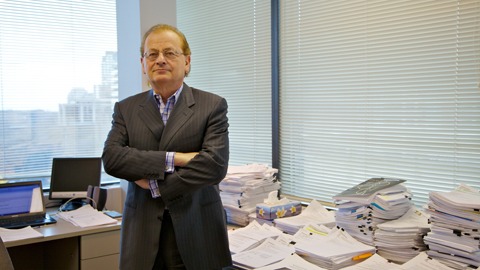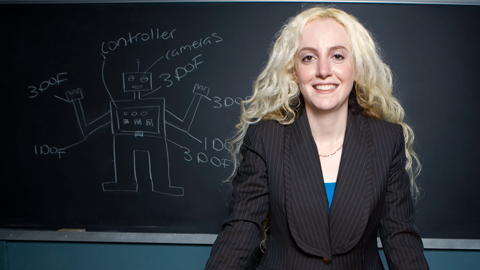

Today’s cutting-edge robotics technology is about making life easier. Many robots are even being developed to do tasks that many would assume only humans can do.
The CBC’s The National spoke to MIE Professors Andrew Goldenberg and Goldie Nejat about their innovations.
Professor Goldenberg and his researchers are perfecting a patroller robot – equipped with security cameras and infrared vision. “The robot actually acts as a human being, in terms of identifying the sources of potential problems,” said Professor Goldenberg.
Professor Nejat’s Brian the Robot is designed to assist in health care facilities and those in long-term care. It is a highly intelligent, human-like, socially assistive and interactive robot. Not only can it display an array of emotions when interacting with humans, it can cognitively stimulate and help with memory functioning through numerous activities.
“This is a robot that is going to interact with you. It understands what you’re saying from your speech, your body language, and then be able to interpret that and have its own assistive behaviour to help you,” said Professor Nejat.
To see the full feature story, visit CBC.ca.
“Energy conservation and renewable energy are key components of our green energy future,” explained MSE PhD candidate Michael G. Helander in a blog post for the Ministry of Economic Development and Innovation.
“With popular demand for flat-panel TVs on the rise, their alarmingly high energy usage … is increasingly becoming the focus of energy conservation efforts,” Helander added.
That is why he along with, PhD candidate Zhibin Wang (MSE) and supervisor Professor Zheng-Hong Lu (MSE), have created the world’s most efficient organic light-emitting diodes (OLEDs) on plastic.
Current OLEDs provide high-contrast and low-energy displays and is rapidly becoming the dominant technology for advanced electronic screens. The U of T Engineering team’s OLED technology has the potential to be significantly more energy efficient than liquid crystal displays (LCDs), while less costly than traditional OLED manufacturing.
“Both OLED displays and new durable solar cells can be manufactured in the province, creating new jobs and investment opportunities,” said Helander. “Together they are poised to play an important role in our green energy economy, creating wealth and skilled labour in Ontario, while saving the environment.”
To read Helander’s article, visit the Ministry of Economic Development and Innovation website.

The average commute time in the Greater Toronto and Hamilton Area will jump by a third in 20 years without a major injection into transit, according to expert calculations.
And the traffic congestion is only going to get worse unless cities answer to the increased demand.
“If we don’t mend our ways, the only thing that will answer congestion is when the jobs disappear because people can’t get to work,” said Professor Eric Miller (CivE), Director of Cities Centre at U of T.
Professor Miller said that cities like Hamilton may not have a congestion issue now, but as an economic and transportation hub, waiting until it comes is too late. Doing nothing, including not building light rail, will come at a heavy price for city growth.
“The first step is the toughest one. There is a leap of faith in the first step, but it has to happen,” he said.
To read the full story, visit the Hamilton Spectator.
Professors Sanjeev Chandra (MIE), Andrew Goldenberg (MIE), Chul Park (MIE), Michael Sefton (ChemE/IBBME) and Paul Young (CivE) have been elected Fellows of the American Association for the Advancement of Science (AAAS). The AAAS is the largest international organization dedicated to advancing science or its applications on a global basis. The University of Toronto received five of the 53 Fellowships awarded in the Engineering Section, more than any other single institution.
Professor Chandra is known internationally for his research on the dynamics of droplets and sprays, which has been applied in the fields of spray coating and forming, spray cooling, ink jet printing, agricultural spraying and forensic sciences. The co-founder and Associate Director of the Centre for Advanced Coating Technologies, he received the 2010 NSERC Brockhouse Canada Prize for Interdisciplinary Research in recognition of his achievements as part of this world-leading organization. Professor Chandra was elected “for distinguished research contributions on the dynamics of droplets and sprays and the advancement of thermal spray coating technology through the Centre for Advanced Coating Technologies.”
Before joining the Faculty in 1982, Professor Goldenberg was employed at SPAR Aerospace Ltd. and participated in the development of the Canadarm, the first space shuttle remote manipulator system. Through his work at the Robotics and Automation Laboratory at U of T and his two successful spin-off companies, Professor Goldenberg is taking a leading role in the development of new robotics technology for a range of industrial sectors – his research has resulted in more than 30 patents. He was elected AAAS Fellow “for contributions to the robotics field by way of sustaining a leading academic career in parallel with founding and leading innovative robotics and automation commercial enterprises.”
Professor Park holds a Canada Research Chair (Tier I) in Microcellular Plastics and is the founding Director of the Microcellular Plastics Manufacturing Laboratory, one of the world’s foremost research institutions in the field of microcellular plastics foaming technology. Professor Park jointly invented the MuCell™ technology for the manufacture of microcellular plastics with superior mechanical properties; this technology has been licensed by over 450 industrial companies. He was elected in recognition of his “distinguished contributions to the field of microcellular plastics through his research, his development of over twenty patented technologies and his creation of international consortia.”
University Professor Sefton is a pioneer in tissue engineering and a world leader in the fields of biomaterials, biomedical engineering and regenerative medicine. He holds the title of University Professor, the highest rank possible at U of T, and the Michael E. Charles Chair in Chemical Engineering. He has co-invented polymers with therapeutic benefits which address limitations in the use of medical devices. These novel materials, termed Theramers™ (for therapeutic polymers) are the first examples of a new class of biomaterials – materials with drug-like activity. He was elected for “distinguished contributions to tissue engineering, particularly the microencapsulation of live cells and combining live cells and synthetic materials to create artificial tissue.”
Currently serving as Vice-President, Research for the University, Professor Young pioneered many of the techniques used today in monitoring and interpreting induced seismicity in the mining, petroleum and nuclear waste disposal industries. His research has significantly advanced our understanding of the mechanics of fracturing in brittle materials, induced seismicity, micromechanical modelling and geophysical imaging. Professor Young has served as founding Director of the Lassonde Institute for Engineering Geoscience and as Chair of the Department of Civil Engineering. His election is based on his “distinguished contributions to research and technological advancement in rock mechanics and geophysics and an exemplary record of service in academic administration.”
“We are grateful and proud that the AAAS has honoured five of our faculty members for their exceptional contributions to engineering,” said Cristina Amon, Dean, Faculty of Applied Science & Engineering. “The continuing recognition of our professors by this prestigious international organization demonstrates the outstanding global reputation our Faculty enjoys.”
The new Fellows will be announced in the December 23 issue of Science and honoured at the AAAS Fellows Forum on February 18, 2012 in Vancouver, B.C.
Can a cellphone bring down an airplane?
That was the question posed by Global News to Professor Sean Victor Hum of The Edward S. Rogers Sr. Department of Electrical & Computer Engineering. The question arises after well-known actor Alec Baldwin was kicked off an airplane for using his cellphone prior to take off.
You can see Professor Hum’s response here.
U of T spin-off company, Interface Biologics Inc. (IBI), founded by Professor Paul Santerre (Director, IBBME), continues to garner technical and commercial success.
On December 6, IBI announced a $1-million investment by Ontario’s Investment Accelerator Fund – Life Sciences (IAF-LS). The IAF-LS helps accelerate the growth of life sciences companies that have the potential to be global leaders in their field and provide sustainable economic benefits to the province.
IBI’s unique materials, such as its Endexo Technology, improve the safety and effectiveness of blood contacting medical devices without changing the mechanical or functional properties – and with minimal manufacturing changes. This announcement also coincides with the company’s 10th anniversary.
In July, IBI announced that the largest provider of dialysis products, Fresenius Medical Care, would apply the company’s Endexo Technology to dialysis circuits for treating end-stage renal disease. And in October, Navilyst Medical launched BioFlo, a peripherally inserted central catheter (PICC) that will use Endexo in five clinical centres in Canada.
As part of the IAF-LS funding, IBI will explore the use of its technology platforms in ophthalmology applications.
“We are very pleased that IAF-LS has made this strategic investment in Interface Biologics, providing financial support to further the commercialization of its innovative technologies,” said Professor Santerre. “This announcement is another example of IBBME’s success in transferring innovative biomaterials and biomedical technology to the healthcare market.”
